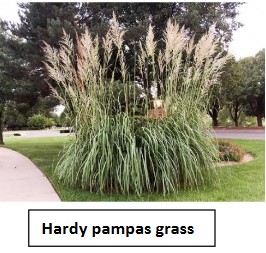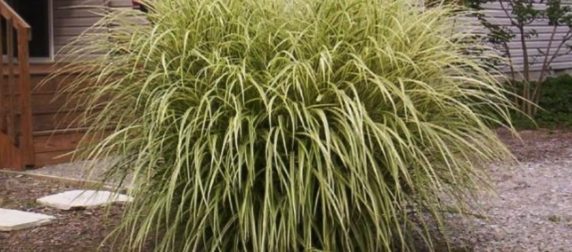Ornamental Grasses
Like Yucca, these are plants that you either love or hate. But ornamental grasses, like many types of plants,can be quite variable and serve many purposes. There are grasses that range from 1’ groundcovers for sun or shade to 12’ screening plants. And, yes, bamboo are grasses but be very careful with bamboo! There are “clumpers” and “runners”. You don’t want the runners.
 One of my favorites is Japanese forest grass (Hakonachloa). This is a low spreading groundcover grass for shady sites. There are many varieties ranging from bright green foliage to bright yellow variegation.
One of my favorites is Japanese forest grass (Hakonachloa). This is a low spreading groundcover grass for shady sites. There are many varieties ranging from bright green foliage to bright yellow variegation.
Most of the commonly seen grasses are Miscanthus (Japanese Eulalia grass) which comes in many textures and variegations and normally reaches the 5-6ft level. This is a good size for screening when you are sitting down on the patio. Then if you stand up you can see over it. Miscanthus will require a hard shearing in the spring. Many folks will be tempted to cut these back in the fall when they turn brown and start to flop. This is OK but I prefer cutting them back in March for several reasons. Number one is that they provide winter interest with the flower stalks swaying in the breeze. The dense foliage also will help to protect the roots from harmful freezing and thawing in winter. Many ornamental grasses dislike our cold wet winters so leaving them up in the winter is helpful.
A good, hardy screening grass that reaches 10-12ft tall is Erianthusor hardy pampas grass. This is a good time to mention that “pampas grass” is NOT HARDY in central Ohio. Some folks refer to any ornamental grass as “pompous grass”. First of all, it’s not pompous, it’s pampas,named for the wide plains of Argentina where it grows naturally. So, pampas grass is not hardy here. But Erianthus is!
 As mentioned this grass can make a large screen over the course of one summer. But beware, it’s a chore to cut down such a large plant each season. That being said, it’s not absolutely necessary to cut grasses back, as no one is cutting them back in nature! But if you want a neater appearance you will want to cut them back. In nature they are often burned off by lightning. Burningis a great way to cut back grasses,but of course,only in the proper situation, weather conditions and never in the city!
As mentioned this grass can make a large screen over the course of one summer. But beware, it’s a chore to cut down such a large plant each season. That being said, it’s not absolutely necessary to cut grasses back, as no one is cutting them back in nature! But if you want a neater appearance you will want to cut them back. In nature they are often burned off by lightning. Burningis a great way to cut back grasses,but of course,only in the proper situation, weather conditions and never in the city!
You should cut back grasses in spring just before the warm up. Pick a nice sunny day in March. You might tie the clumps together before cutting for ease of later disposal. Then use a hedge trimmer for easiest cutting and cut them about a foot above the ground. Now the warm spring sun can reach the soil to warm up the roots and encourage that nice, fresh new growth for many seasons of decoration.Grasses are great for hiding the utilities, trash cans, the neighbor’s shed or just fronting large pine or spruce trees.



Comments are closed.